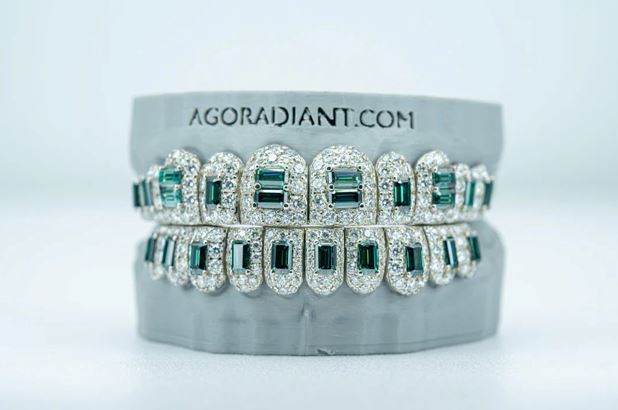The Evolution of Jewelry in Rap: From Gold Chains to Grillz
As Rap Culture emerged on the streets of New York, jewelry became a status symbol among emerging artists. By wearing and showing off different types of jewelry, artists could signal to their peers the level of success they had within the industry by achieving wealth and recognition or rather the adversity they had overcome to get there. From gold chains to diamond rings, each piece of jewelry added another level of status. The boldness of the jewelry acts as contrast to the artist’s once humble beginnings, a commonality for many rap artists and musicians.
For many artists, the jewelry also symbolizes empowerment and independence, a message against the traditional stereotype of luxury and opulence. Gold chains and grillz for example are prominent in rap culture due to their roots within the personal experiences of rap’s founding artists. Here’s how all that came to be.
Early Days: Gold Chains as the Ultimate Status Symbol
Gold chains are significant because they represent the first status symbol for the black artists of hip-hop and rap. While the gold chains as they are can be traced back to the 1970s and 1980s during the birth of hip-hop as a cultural movement, its roots go back even further as African heritage where gold has historically represented wealth, power and status. As rap culture emerged, artists adopted the style of gold chains to embody the same ideals. For many artists who grew up in marginalized communities, gold chains were the first to symbolize overcoming adversity and attaining success and recognition.
Pioneering artists like Grandmaster Flash, Run-D.M.C., and LL Cool J helped popularize gold chains as an essential part of the hip-hop aesthetic. The chains were a visual break from away from poverty, embodying the resilience and ambition of the artists wearing them. Over time, gold chains evolved into an iconic emblem of the genre, signaling prestige, achievement, and the ability to define one’s own narrative of success. This extended further into the design and size of the gold chains. Where they represent overcoming adversity and attaining success, the bigger and more elaborate chains the chains were, the more that they represented victory over hardship. Over time, the designs have also come to represent the artist’s own story and personal experiences. Either by including nods to their story or particular lyrics, they showcase their individuality and identity.
The 90s: The Era of Excess and Bling
The trend of bigger and better didn’t stop any time soon. By the 1990s, jewelry only got larger in size and flashier. Rappers and hip-hop artists continued to wear bigger, flashier jewelry to show off their success and wealth. Its presence in the media only further deepened the portrayal of a luxurious lifestyle. Despite the extravagance of its scale, its acknowledgement as a status symbol and depiction of wealth didn’t fall off.
At the same time, the jewelry subculture also opted to showcase each artist’s individualism. Much like how chains did, rappers and hip-hop artists customized their rings and pendants in order to display key aspects of their identity such as affiliation or accomplishments.
The Turn of the Millennium: Platinum and Diamond Domination
By the turn of the millennium, there was a shift towards platinum instead of gold. For many it represented greater wealth due to the higher rarity of platinum compared to gold. It was an aesthetic pushed by the turn of the millennium, moving towards a more polished and futuristic style compared to the traditional appeal of gold. Influenced by artists such as Jay-Z, Nelly and 50 Cent, their public appearances and lyrics reinforced the idea that platinum was the new standard of success.
At the same time, diamonds began to grow in popularity as artists used them to decorate their accessories. From diamond-studded chains to diamond-studded watches, the fashion of “bling-bling” dazzled this era, leaving behind a permanent and lasting cultural impact.
The Emergence of Grillz: A New Symbol of Prestige
The history of grillz dates back long before their cultural emergence during the 1970s. Archeologists and historians have traced back the practice of dental adornments and tooth embellishment to early mesoamerican civilization and african tribes. Much like other jewelry, there were symbol pieces, representing social status, beauty and affiliation.
The modern form of grillz began to take shape in New York City during the 1970s. Through the effort of pioneering jeweler, Eddie Plein, gold teeth were popularized before soon being commissioned by hip-hop artists. Just like any jewelry, they represented wealth and status.
By the 2000s, Nelly’s hit single, “Grillz”, brought the unique accessory to the mainstream. Custom diamond grillz such as those made by Paul Wall became luxury items as well as the newest accessories to add a rapper’s unique style into their visual aesthetics. This was especially evident in cities such as Houston and Atlanta which raised the popularity of grillz. Alongside artists such as Lil Wayne, who often wore diamond grillz, their status was only cemented as part of a rapper’s must-have fashion pieces within the larger hip-hop community.
Modern Aesthetics: Piece by Piece
Nowadays, the modern aesthetics of rappers and hip-hop artists have been influenced by the globalized community. Each artist finds their own unique blend of luxury, streetwear and personal expression that transcends traditional norms. Hip-Hop culture has blended as well with the influences of high fashion allowing the modern aesthetic a truly dynamic range of styles from top to bottom.
By combining fashion pieces with jewelry, rap artists form a unique style that compliments their work through their visual aesthetics within their public content. Through their presences in music videos, album art, public appearances and social media, rap artists can present themselves as much as they want. Whether its elaborate customized and fashion show worthy outfits to Snoop Dog showing his support for Team USA at the 2024 Paris Olympics with custom t-shirts, the range that artists have to begin painting their apparel canvas is limitless. From there, jewelry is a second layer of aesthetics to accent each individual outfit.
From where the level of today’s aesthetics are, the jewelry of rap culture feels so much like humble beginnings. Over time they’ve evolved with their place beside the scale of hip-hop and rap and there’s no slowing down. By incorporating them clearly and purposefully, artists are able to visually show their story of resilience, creativity and success towards their fans. ‘Cause while it’s important for you to know your story, it ain’t bad if everyone knows it too.





